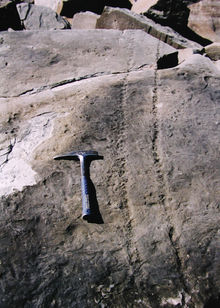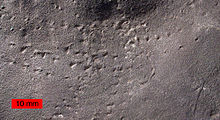- Diplichnites
-
Diplichnites is an ichnogenus thought to be made by members of the Phylum Arthropoda. It is a fossil trackway showing two parallel lines of feet impressions. The famous terrestrial arthropod genus Arthropleura produces the trace fossil D. cuithensis. Diplichnites is traditionally thought to be a trilobite trace fossil; however, it is also produced by other organisms such as freshwater and terrestrial arthropods of unknown affinity (possibly including myriapods).[1]
 Oblique bedding plane view of large Diplichnites from the Joggins Formation (Pennsylvanian), Cumberland Basin, Nova Scotia. This trackway was made by the millipede Arthropleura.
Oblique bedding plane view of large Diplichnites from the Joggins Formation (Pennsylvanian), Cumberland Basin, Nova Scotia. This trackway was made by the millipede Arthropleura.
Trilobite ichnotaxa: stationary to full stride
Three ichnotaxa describe trilobite motion: Rusophycus (resting), Cruziana (furrowing), and Diplichnites (walking). For the trilobites, gradations between the three ichnotaxa are common and often difficult to categorize.[2]
External links
Diplichnites:
- Photo--Diplichnites gouldi arthropod trackway--(marine, tidal); Article – "Bulletin 241", Kansas Geological Survey
- Photo--from Arthropleura sp; Article – "Nova Scotia, Carboniferous Geology and Paleontology"
Trilobite Tracks:
- Trilobite Trace Fossils – 3-main types of trilobite trace fossils
References
- ^ Woolfe, K.J. (1990). "Trace fossils as paleoenvironmental indicators in the Taylor Group (Devonian) of Antarctica". Palaeogeography, Palaeoclimatology, Palaeoecology 80 (3–4): 301–310. doi:10.1016/0031-0182(90)90139-X.
- ^ Garlock, T. L.; Isaacson, P. E. (1977). "An occurrence of a Cruziana population in the Moyer Ridge Member of the Bloomsberg Formation (Late Silurian)-Snyder County, Pennsylvania". Palaeontology (Paleontological Society) 51 (2): 282–287. JSTOR 1303607

This trace fossil-related article is a stub. You can help Wikipedia by expanding it.

